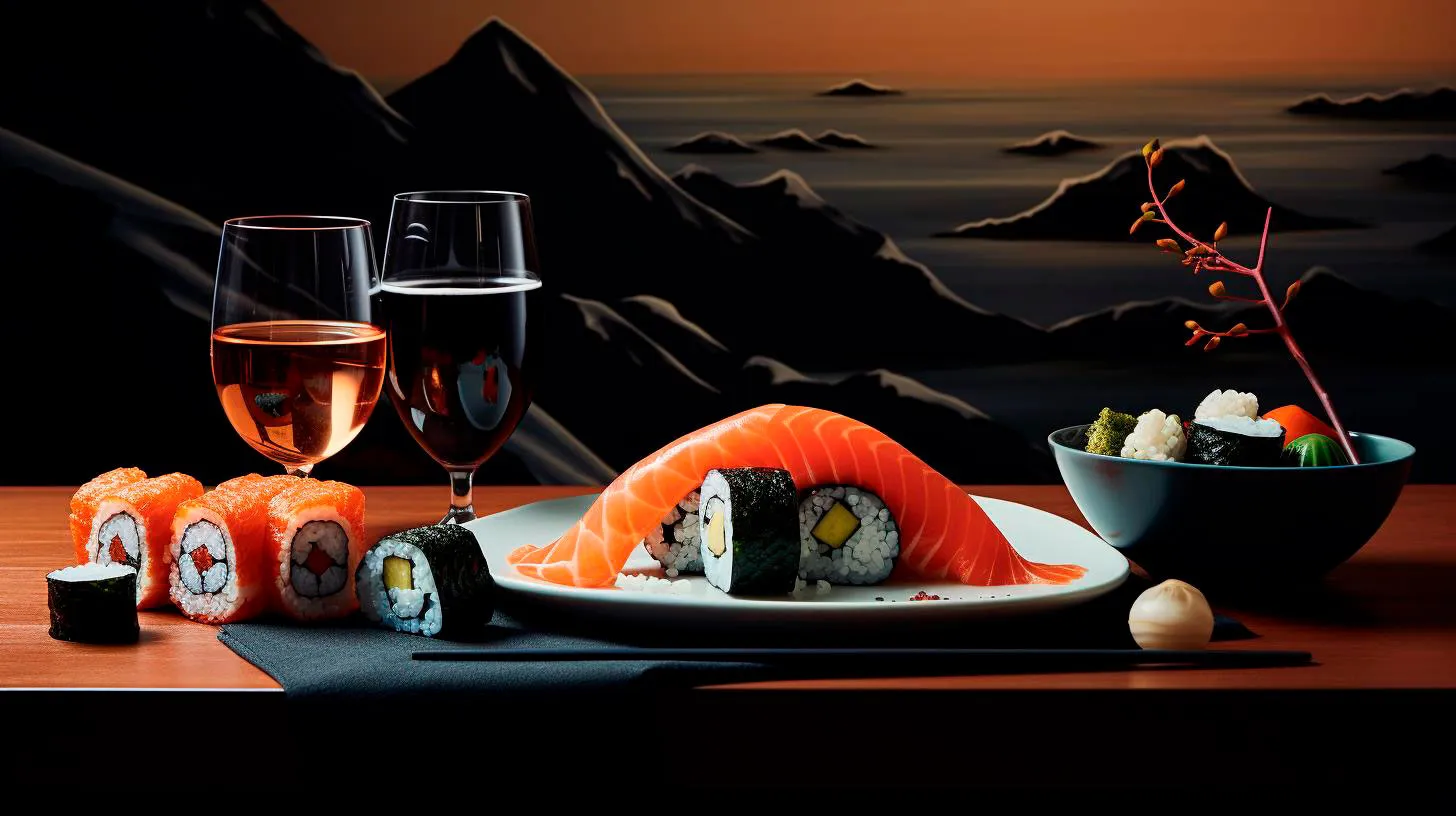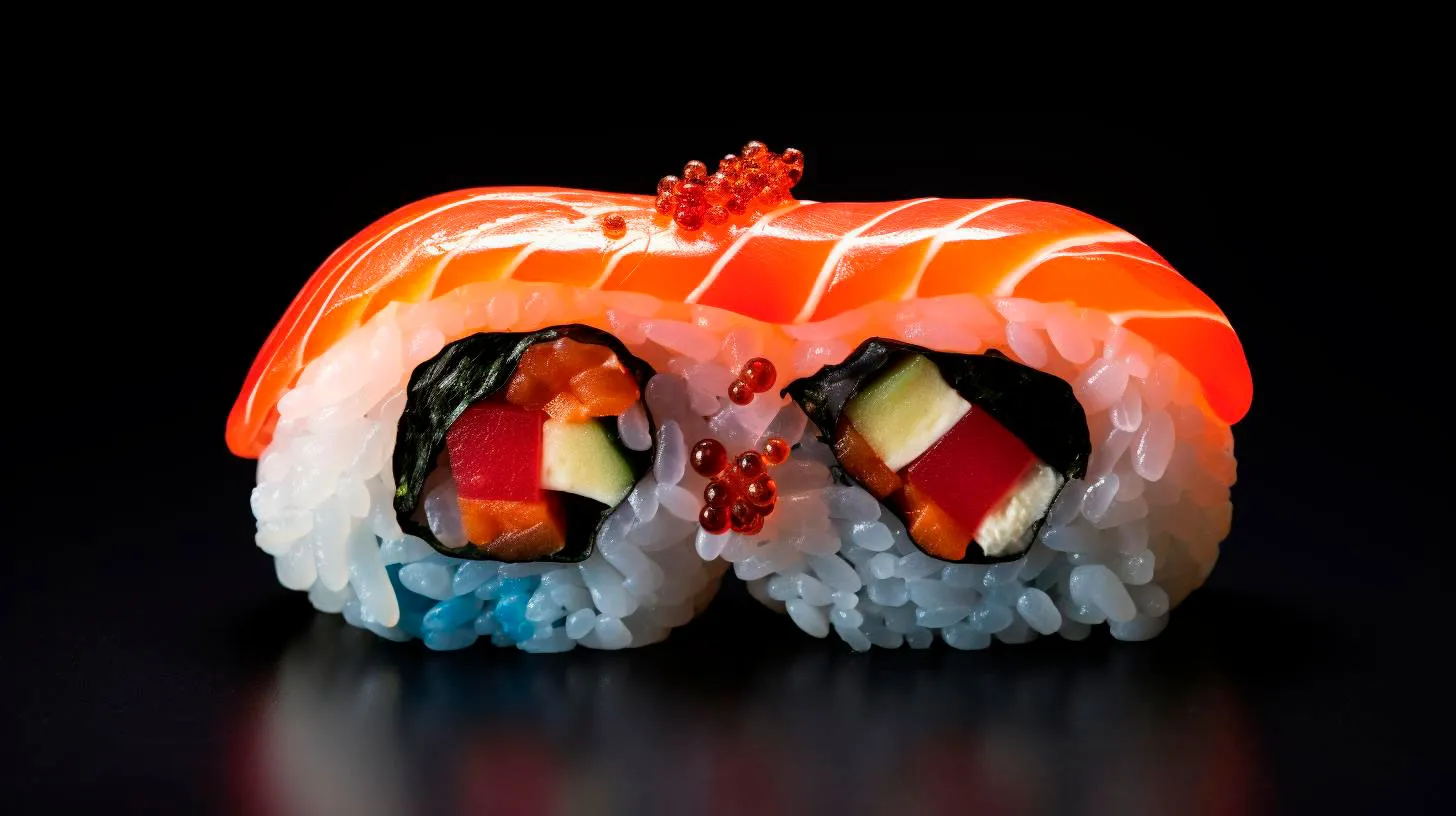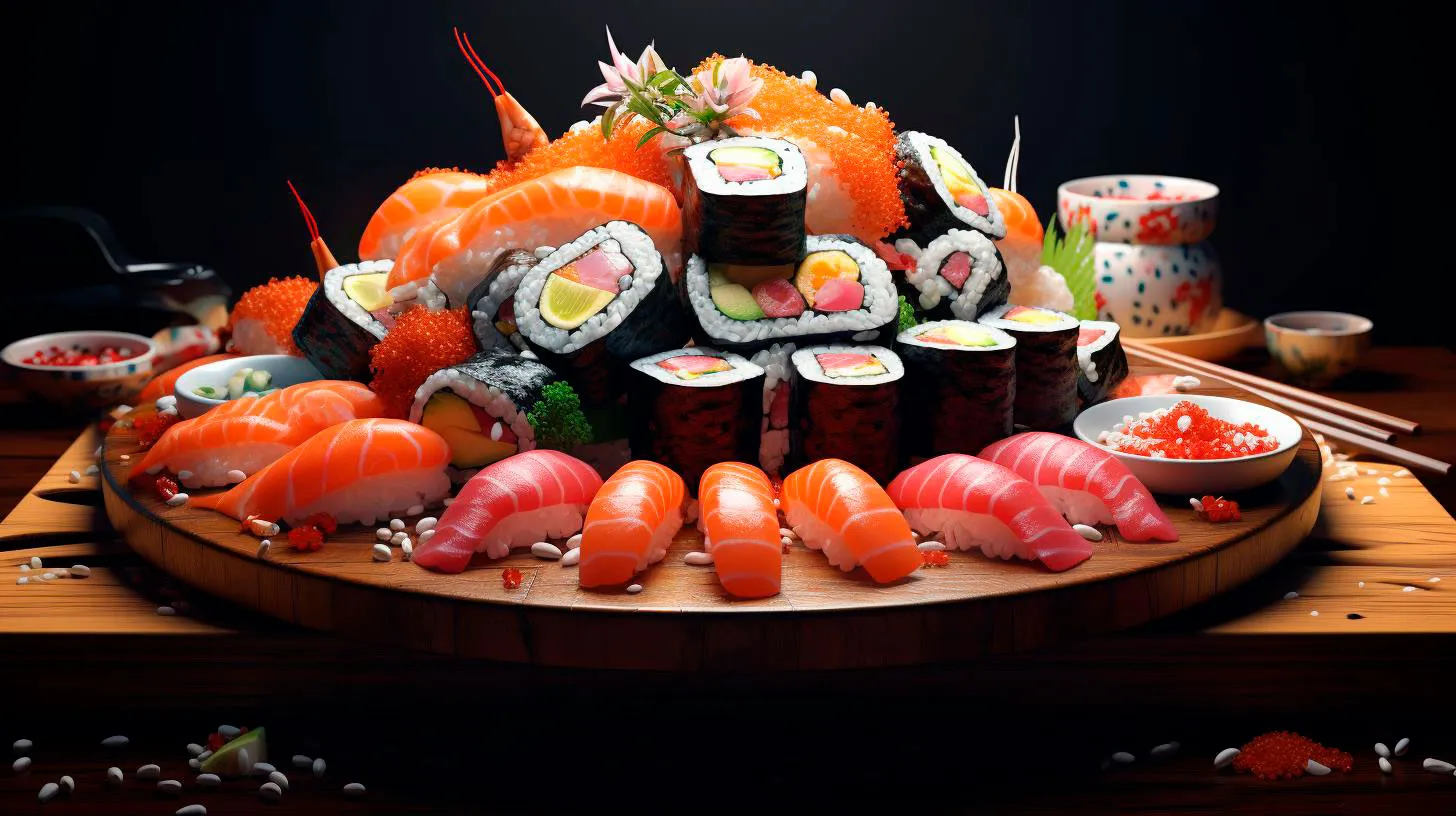From Ocean to Table: The Journey of Sushi Tradition
In this article, we will explore the journey of sushi tradition, from its humble beginnings to its current status as an international sensation.
The Birth of Sushi
The history of sushi dates back to the 8th century in Japan. Originally, sushi was created as a way to preserve fish. By fermenting raw fish with rice and salt, the Japanese found a way to ensure that the fish remained edible for extended periods, allowing them to store it for future consumption. This early form of sushi was known as “narezushi,” and it laid the foundation for the sushi we know today.
It wasn’t until the 19th century that sushi evolved into its modern form. Edo, now known as Tokyo, became the epicenter of sushi innovation. A street food stall called “yatai” introduced the concept of nigiri sushi, where bite-sized portions of fresh fish were placed on top of a small mound of vinegared rice. This revolutionary technique allowed people to enjoy the flavors of the fish while still preserving its freshness.
The Art of Sushi Making
Making sushi is an intricate process that requires skill, precision, and an understanding of flavor combinations. Here are some key steps in the sushi-making journey:
- Selection of Fresh Ingredients: The first and most crucial step is sourcing high-quality, fresh fish and other ingredients. Sushi chefs prioritize freshness to ensure that the flavors are at their peak.
- Preparation: The fish is meticulously cleaned, deboned, and sliced. Additional ingredients such as avocado, cucumber, or shrimp may be prepared to complement the fish.
- Sushi Rice: Sushi rice is the foundation of every sushi dish. Rice grains are cooked and then mixed with vinegar, sugar, and salt to achieve the perfect balance of flavors.
- Creating Nigiri: Each piece of nigiri sushi is carefully crafted by placing a slice of fish or other toppings on a small bed of seasoned rice. The chef molds it with their hands, ensuring the perfect balance of textures.
- Rolling Maki: Maki sushi, or sushi rolls, are created by rolling a sheet of seaweed (nori) around a filling of rice, fish, and vegetables. The roll is then sliced into bite-sized pieces.
- Presentation: The final step involves arranging the sushi on a plate, taking into consideration color, texture, and presentation. Wasabi, soy sauce, and pickled ginger are often served as accompaniments.
The Popularity of Sushi
In recent years, sushi has experienced an exponential increase in popularity, transcending cultural boundaries and becoming a favorite choice for many. Here are some reasons why sushi has captured the hearts (and taste buds) of people all over the world:
- Health Benefits: Sushi is generally considered a healthy choice due to its fresh ingredients and minimal use of oil. It is rich in omega-3 fatty acids, protein, and essential vitamins.
- Variety of Flavors: With a vast array of fish, seafood, and vegetable options, sushi offers an explosion of flavors and textures. From the delicate and buttery taste of tuna to the crunchiness of tempura, there is something for every palate.
- Visual Appeal: Sushi’s artful presentation is a feast for the eyes. The vibrant colors, meticulous arrangements, and attention to detail make every plate of sushi a visual delight.
- Social Dining Experience: Sushi is often enjoyed in a communal setting, encouraging interaction and shared experiences. It has become a popular choice for social gatherings, allowing friends and family to bond over a meal.
Sushi: A Global Phenomenon
The popularity of sushi is evident in the following statistics:
- In the United States alone, sushi consumption has increased by over 40% in the past decade.
- Japan, the birthplace of sushi, boasts over 45,000 sushi restaurants.
- Sushi has become a staple in many countries worldwide, including Brazil, Australia, and the United Kingdom.
As the demand for sushi continues to rise, sushi chefs and restaurants around the world are finding innovative ways to cater to diverse tastes and dietary preferences. Vegetarian and vegan sushi options have become increasingly common, allowing individuals with dietary restrictions to enjoy this culinary delight.
Key Takeaways
Sushi has come a long way from being a preservation method to becoming an international food phenomenon. Here are some key takeaways about the journey of sushi tradition:
- Sushi originated in Japan as a way to preserve fish, but it has evolved into an art form and a global delicacy.
- The sushi-making process involves careful selection of fresh ingredients, meticulous preparation, and attention to presentation.
- Sushi offers numerous health benefits and a variety of flavors, making it a popular choice for food enthusiasts worldwide.
- Sushi has become a social dining experience, allowing people to bond over a shared love for this culinary delight.
- Sushi’s popularity continues to grow, with a significant increase in consumption and the emergence of sushi restaurants worldwide.
From its humble beginnings as a preservation method to its current status as a globally cherished cuisine, sushi has undoubtedly made a remarkable journey. So, the next time you savor a piece of sushi, take a moment to appreciate the rich history and tradition behind it.
Ensuring Authenticity: Safeguarding the Legacy of Sushi
However, the increasing popularity of sushi has given rise to concerns about authenticity and the preservation of its rich legacy.
The Artistry and Traditions of Sushi
Sushi, at its core, is an art form that demands precision, skill, and unwavering dedication. Mastering the art of sushi requires years of training and an unwavering commitment to quality. Every step of the sushi-making process is carefully thought out, from selecting the freshest ingredients to the delicate balance of flavors. It is this attention to detail that distinguishes authentic sushi from imitations.
Traditions play a pivotal role in preserving the authenticity of sushi. Passed down from generation to generation, these time-honored practices ensure that every piece of sushi pays homage to its cultural roots. Sushi chefs not only possess technical expertise but also embody a deep respect for tradition, creating an experience that goes beyond mere sustenance.
- Authentic sushi relies on the use of high-quality, seasonal ingredients, emphasizing freshness and flavor.
- Sushi making requires meticulous attention to detail and precision to achieve the perfect balance of textures and tastes.
- Respecting cultural traditions ensures the preservation of sushi’s authenticity and legacy.
The Rise of Sushi’s Popularity
In recent years, sushi has experienced an unprecedented surge in popularity worldwide. This rise in demand has presented both opportunities and challenges for sushi establishments. While it has allowed sushi to reach a broader audience, it has also created a market for cheaper imitations and compromised quality.
The global sushi market is anticipated to grow at a CAGR of 3.3% from 2021 to 2028, reaching a market value of $19.1 billion by 2028 (source: Grand View Research). However, ensuring the authenticity of sushi becomes increasingly critical as this culinary gem continues to captivate food enthusiasts worldwide.
Safeguarding Authenticity
Maintaining the authenticity of sushi is crucial in preserving its cultural significance and ensuring an unforgettable dining experience. Here are a few key strategies that sushi establishments can employ to safeguard its legacy:
1. Partnering with Trusted Suppliers
The foundation for authentic sushi lies in sourcing the finest ingredients. Partnering with trusted suppliers who share the same commitment to quality is essential. Building strong relationships with fishermen, farmers, and distributors ensures a consistent supply of fresh, seasonal ingredients.
2. Emphasizing Craftsmanship and Training
Investing in the training and development of sushi chefs is a vital step in preserving authenticity. By fostering a deep understanding of traditional techniques, sushi establishments can maintain the highest standards of craftsmanship. This commitment to excellence is what sets authentic sushi apart.
3. Encouraging Collaboration and Innovation
While tradition forms the heart of sushi, encouraging collaboration and innovation can help sushi evolve while staying true to its roots. By embracing new techniques and ingredients, sushi chefs can create innovative dishes that push culinary boundaries, all while maintaining the essence of authentic sushi.
The Key Takeaways
Ensuring the authenticity of sushi is a shared responsibility. Whether you are a sushi enthusiast or a restaurant owner, preserving the legacy of this beloved dish requires attention to detail, respect for tradition, and a commitment to quality.
- Authentic sushi is a product of craftsmanship, tradition, and a commitment to quality.
- Preserving the legacy of sushi requires partnerships with trusted suppliers and a focus on sourcing the finest ingredients.
- Training sushi chefs in traditional techniques and encouraging innovation helps strike a balance between tradition and evolution.
- Authenticity is a shared responsibility, and by safeguarding the legacy of sushi, we ensure its continued enjoyment for generations to come.
Let us celebrate the timeless artistry and flavors of authentic sushi and honor the traditions that have stood the test of time. Together, we can ensure that every bite of sushi offers a genuine taste of Japanese culinary perfection.
Preserving the Art: Passing on Ancient Sushi Techniques
However, with the rapid modernization of food preparation techniques, there is a growing concern that these time-honored skills may be lost. In this article, we delve into the importance of preserving the art of sushi-making and how chefs and organizations are making efforts to pass on these ancient techniques to future generations.
The Purity in Tradition
Traditional sushi-making is not just about creating a tasty meal; it is a reflection of the rich heritage and cultural identity of Japan. The careful selection of ingredients, the meticulous preparation, and the refined presentation are all fundamental aspects that contribute to its authenticity. While modern sushi has evolved to cater to various palates and dietary needs, there is a certain purity and beauty in preserving the original methods.
The Significance of Handcrafted Sushi
When it comes to sushi, the human touch cannot be replicated by machines. Handcrafted sushi requires years of practice to achieve the perfect balance of flavors and textures. Each piece holds the spirit of the chef who crafted it, adding an irreplaceable personal touch. It is this essence of the artisan that sets traditional sushi apart from its mass-produced counterparts.
Moreover, hand-pressed nigiri, a traditional style of sushi, allows the chef to tailor each piece to the ideal size and shape to maximize the enjoyment for the consumer. This attention to detail and dedication is what makes sushi an art that transcends taste.
Preservation Efforts
Recognizing the importance of preserving these ancient sushi techniques, various organizations and sushi masters are working diligently to pass on their knowledge to future generations. Here are some notable initiatives:
- Sushi Schools: Several sushi schools and academies have been established in Japan and around the world, aiming to teach aspiring chefs the fundamentals of traditional sushi-making. These schools provide comprehensive training in various techniques, including knife skills, rice preparation, and presentation.
- Mentorship Programs: Experienced sushi chefs mentor young apprentices, guiding them through the intricacies of the craft. This traditional method of passing on knowledge allows for hands-on learning and instills respect for the art form.
- Documenting Techniques: Oral tradition has long been used to pass on sushi-making skills, but efforts are being made to document these techniques. Videos, books, and online content help preserve the knowledge, making it accessible to a wider audience and preventing its loss.
- Preservation Associations: Various sushi preservation associations have been established to safeguard traditional sushi-making. These organizations play a pivotal role in advocating for the preservation of ancient techniques while fostering innovation within the industry.
The Future of Sushi-Making
With the concerted efforts to pass on ancient sushi-making techniques, the future of this revered culinary art looks promising. As aspiring chefs embrace the traditional methods while infusing their own creativity, the legacy of sushi is sure to be preserved and celebrated for generations to come.
Key Takeaways
- Preserving the ancient techniques of sushi-making is crucial to maintain the cultural identity of Japan.
- Handcrafted sushi holds a unique appeal that mass-produced sushi cannot replicate.
- Initiatives such as sushi schools, mentorship programs, and documentation efforts are helping to transfer knowledge to the next generation.
- Sushi preservation associations play a vital role in safeguarding traditional techniques while encouraging innovation.
- The future of sushi-making relies on a harmonious blend of tradition and creative adaptation.
By preserving the art of sushi-making and passing on these ancient techniques, we not only ensure the continuation of a culinary masterpiece but also honor the cultural heritage of Japan. Handcrafted sushi will always hold a place of reverence in the world of gastronomy, reminding us of the beauty that can be achieved when tradition and innovation intertwine.
Balancing Tradition and Innovation: Sustainable Sushi Practices
The Importance of Sustainable Sushi Practices
Sushi, originating from Japan, has been enjoyed for centuries as a delicacy that combines fresh seafood with vinegared rice. However, with overfishing and environmental concerns becoming more prominent, the traditional sushi industry faces challenges in maintaining its practices while ensuring the conservation of marine resources.
Sustainable sushi practices serve as a solution to these challenges. By following these practices, sushi restaurants and seafood suppliers can contribute to the preservation of marine ecosystems, reduce carbon footprint, support local communities, and provide healthier dining options.
Advantages of Sustainable Sushi Practices
1. Preserving Marine Ecosystems: Sustainable sushi practices prioritize the use of responsibly sourced seafood. By avoiding overfished or endangered species, these practices help maintain the balance of marine ecosystems and protect biodiversity.
2. Reducing Environmental Impact: Sustainable sushi practices can significantly reduce the environmental footprint of the sushi industry. This can be achieved through various strategies, such as using energy-efficient equipment, supporting sustainable aquaculture, and minimizing plastic waste.
3. Supporting Local Communities: Embracing sustainable sourcing contributes to the growth of local fishing communities. By partnering with local fishers, sushi restaurants can support the livelihoods of these communities, promoting economic stability and preserving cultural traditions.
4. Healthier Dining Options: Sustainable sushi practices often prioritize the use of high-quality, responsibly sourced seafood. This not only ensures a delicious dining experience but also reduces the risk of consuming seafood contaminated with harmful substances.
Key Takeaways
1. Choose Responsibly Sourced Sushi: When dining at sushi restaurants, opt for establishments that prioritize sustainable sourcing and practices. Look for labels or certifications that indicate responsible seafood choices.
2. Support Local and Sustainable: Whenever possible, choose sushi made from locally sourced ingredients. This not only supports your local community but also reduces the carbon footprint associated with long-distance transportation.
3. Explore Alternative Sushi Choices: Traditional sushi relies heavily on high-demand seafood species. Try exploring innovative sushi options that utilize less commonly used fish or even vegetarian ingredients. This allows you to enjoy the flavors of sushi while minimizing environmental impact.
4. Spread Awareness: Educate others about the importance of sustainable sushi practices. Encourage your friends, family, and colleagues to make informed choices when it comes to sushi consumption. Together, we can create a more sustainable future for this beloved cuisine.
By balancing tradition and innovation in the sushi industry, we can create a future where sushi remains a cultural icon while promoting the well-being of our oceans and marine life. Embracing sustainable sushi practices ensures that current and future generations can continue to indulge in this delectable cuisine without compromising the environment.



